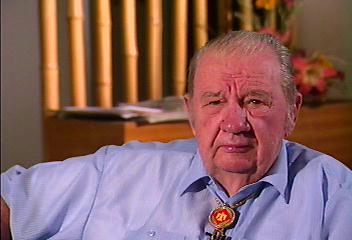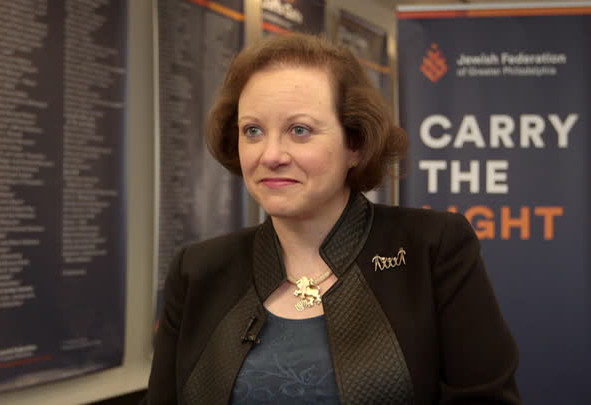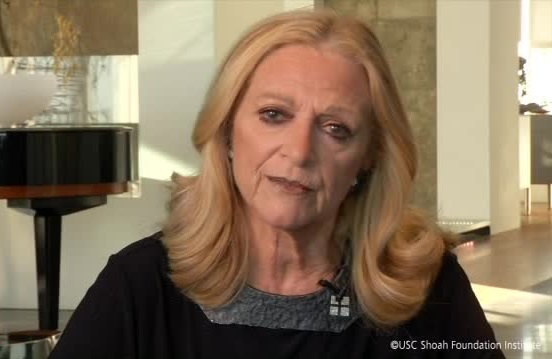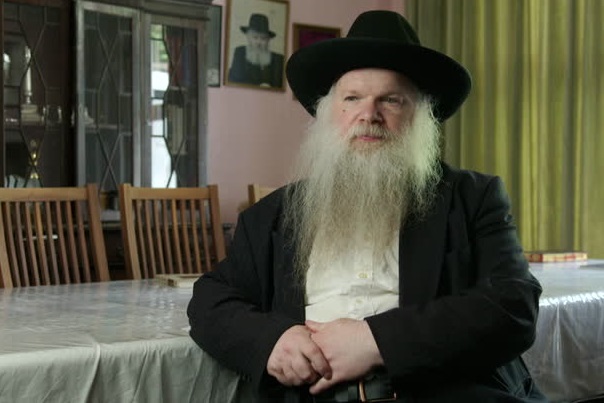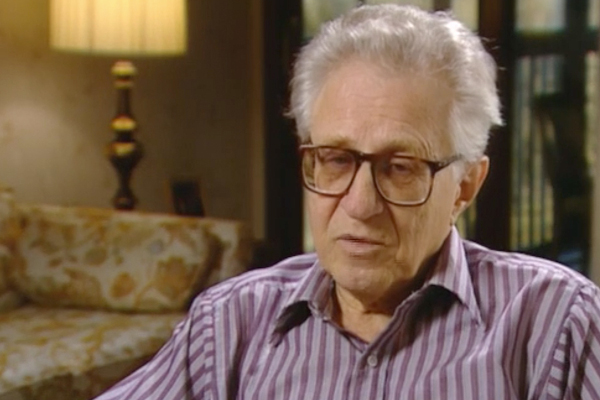LESSON PLAN
EDUCATOR RESOURCE: LESSON PLANS
Our Lesson Plans provide a unique experience for educators to teach about the Holocaust effectively and interactively. The modular design of the lessons found within each unit allow for adaption and customization to specific grade levels and subject areas. The integration of rich content helps students construct an authentic and comprehensive portrait of the past as they frame their own thoughts about what they are learning, resulting in a deeper level of interest and inquiry. Each lesson includes:
- Step-by-step procedures
- Estimated completion time
- Resources labeled by icons






 direct teachers to the piece of content named in the procedures
direct teachers to the piece of content named in the procedures
- Print-ready pages as indicated by
 are available as PDFs for download
are available as PDFs for download
If you are new to teaching about the Holocaust, we encourage you to participate in one of our
online course offerings to support instruction ahead. As well, for teachers with limited instructional time seeking a starting point, we offer a sample
One Day Lesson Plan, as well as a sample
Day Two Lesson Plan for a 2nd class period of instruction.
For more information, questions or concerns please
contact us.
CLASSROOM POSTER SERIES
INSPIRING THE HUMAN STORY
Echoes & Reflections is excited to announce that our poster series:
Inspiring the Human Story, is now available in PDF format,
free of cost.
The posters feature the powerful words and experiences of Holocaust survivor and memoirist
Elie Wiesel, Holocaust survivor
Kurt Messerschmidt, and Anne Frank rescuer,
Miep Gies. Each poster promotes meaningful conversation and reflection in the classroom, whether in person or in a virtual setting, and inspires students with powerful human stories of the Holocaust that can continue to guide agency and action as a result of studying this topic.
To support you in these efforts, we have also compiled several suggested
classroom activities from teachers in our network that may be of use and interest.
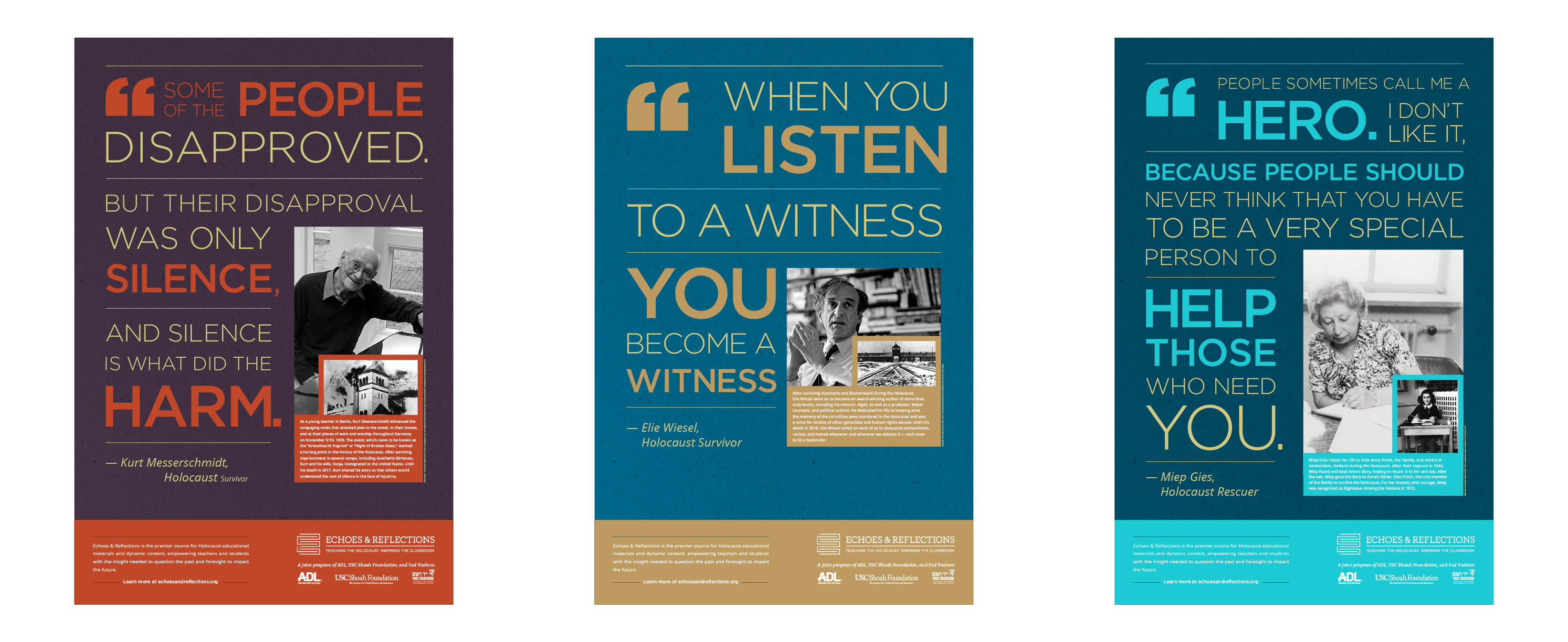
Please fill out the form below to access and download your PDF posters.
WE SHARE THE SAME SKY
USC Shoah Foundation’s seven-part podcast, We Share The Same Sky, seeks to brings the past into present through a granddaughter’s journey to retrace her grandmother’s story of survival. We Share The Same Sky tells the two stories of these women—the grandmother, Hana, a refugee who remained one step ahead of the Nazis at every turn, and the granddaughter, Rachael, on a search to retrace her grandmother’s history.
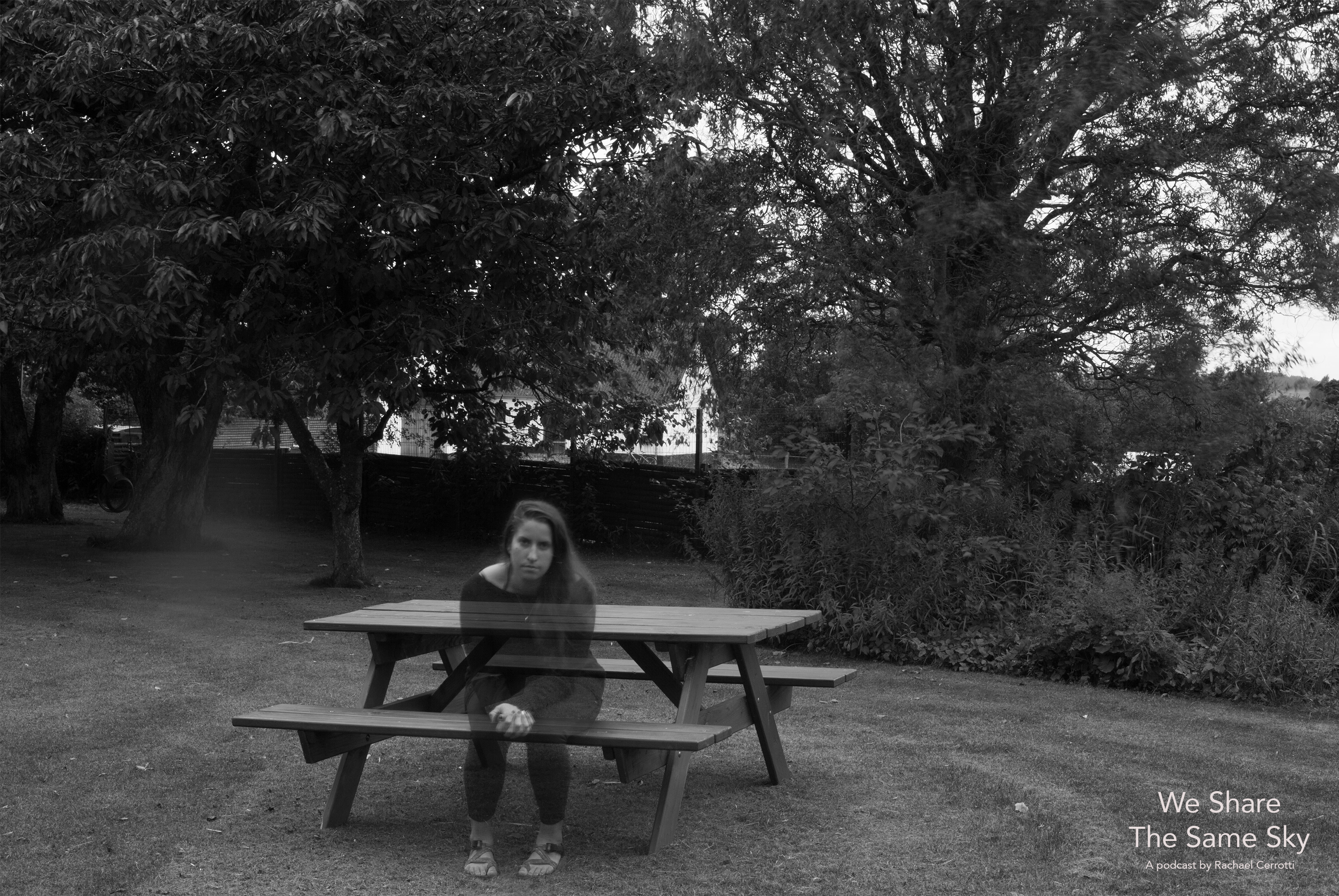 A self-portrait of Rachael while she is living on a Danish farm that is owned by the granddaughter of Hana’s foster mother from World War II. Photo by Rachael Cerrotti, 2017
A self-portrait of Rachael while she is living on a Danish farm that is owned by the granddaughter of Hana’s foster mother from World War II. Photo by Rachael Cerrotti, 2017
In order to enhance classroom use, USC Shoah Foundation and Echoes & Reflections created a Companion Educational Resource to support teachers as they introduce the podcast to students. This document provides essential questions for students, as well as additional resources and content to help build context and framing for students’ understanding of the historical events addressed in the podcast.
Access to the podcast, as well as additional supporting materials can all be found at the We Share The Same Sky page in IWitness.
Note: Due to the subject nature, the podcast is appropriate for older students, grades 10-12. As always, teachers should review the content fully in advance to determine its appropriateness for their student population.

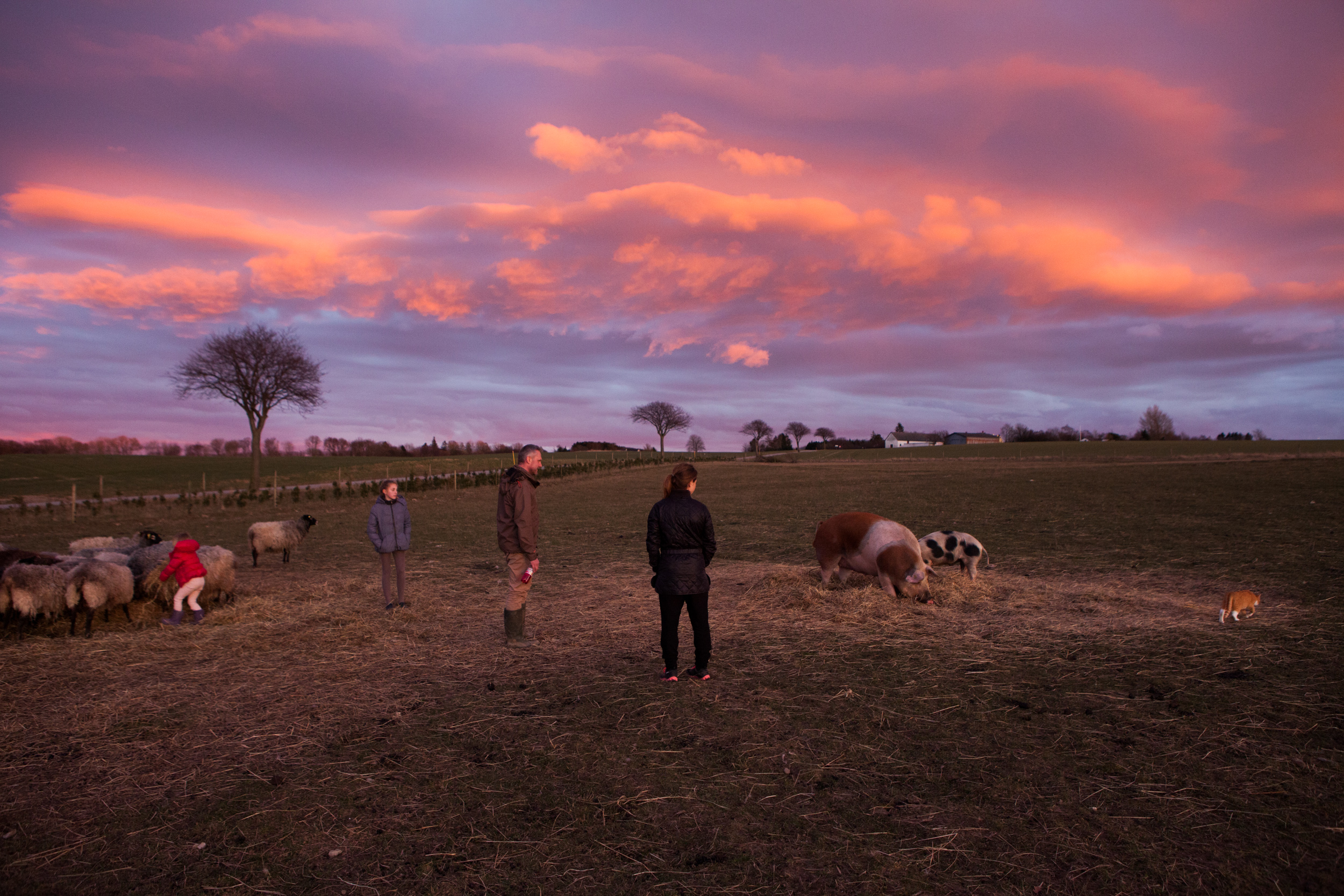 After many years of research and digitizing the archive her grandmother left behind, Rachael set out to retrace her grandmother’s 17 years of statelessness. Her intention was to travel via the same modes of transportation and to live similar style lives as to what her grandmother did during the war and in the years after. That meant that when she got to Denmark, she moved to a farm. Rachael moved in with the granddaughter of her grandmother’s foster mother from World War II and traded her labor for room and board as Hana once did. This picture is from that first visit in the winter of 2015. Since this time, Rachael has spent many more months living on this farm. It is owned by Sine Christiansen and her family. Sine is the granddaughter of Jensine, one Hana’s foster mother from World War II. Photo by Rachael Cerrotti, 2015
After many years of research and digitizing the archive her grandmother left behind, Rachael set out to retrace her grandmother’s 17 years of statelessness. Her intention was to travel via the same modes of transportation and to live similar style lives as to what her grandmother did during the war and in the years after. That meant that when she got to Denmark, she moved to a farm. Rachael moved in with the granddaughter of her grandmother’s foster mother from World War II and traded her labor for room and board as Hana once did. This picture is from that first visit in the winter of 2015. Since this time, Rachael has spent many more months living on this farm. It is owned by Sine Christiansen and her family. Sine is the granddaughter of Jensine, one Hana’s foster mother from World War II. Photo by Rachael Cerrotti, 2015
 A self portrait of Rachael overlooking the exact spot in Southern Sweden where her grandmother’s refugee boat came to shore in 1943. Photo by Rachael Cerrotti, 2016
A self portrait of Rachael overlooking the exact spot in Southern Sweden where her grandmother’s refugee boat came to shore in 1943. Photo by Rachael Cerrotti, 2016


![]() ESTIMATED COMPLETION TIME
ESTIMATED COMPLETION TIME125 minutes
LESSON 2: The New Antisemitism
Introduction 
In this lesson, learners deepen their understanding about the features of contemporary antisemitism and the ways in which they exploit age-old hatred of Jews. Students are introduced to and examine some of the different forces that drive antisemitism in today’s world, including white nationalism, Holocaust denial and distortion, and delegitimization of Israel.
Post the supporting question above for students as you begin this part of the lesson.
| 1 | The Expressions of Antisemitism handout is projected and reviewed as a class. Students learn that in this lesson they will focus on contemporary or “New expressions of antisemitism,” which have both similarities and differences to earlier periods in history.
|
| 2 | Students share any prior knowledge they may have about the Tree of Life Synagogue attack that took place in Pittsburgh in 2018. The following background is shared as needed:
|
On the morning of October 27, 2018 (a Saturday, the Jewish holy day) Robert Bowers entered the Tree of Life Synagogue in Pittsburgh, PA yelling “All Jews must die!” He opened fire on the congregants, killing eleven and wounding six others. Bowers told a law enforcement officer that Jews “were committing genocide against his people.” Authorities later found virulent antisemitic, xenophobic, and anti-immigrant posts on Bowers’ social media profiles. The last of his posts reflecting his belief that Jews are enabling undocumented immigrants to enter the U.S.–stated that “[Jewish organizations] like to bring invaders in that kill our people. I can’t sit by and watch my people get slaughtered. Screw your optics, I’m going in.” The Tree of Life shooting is the deadliest attack on the Jewish community in U.S. history.
| 3 | The Tree of Life Synagogue Attack Word Cloud handout is projected or distributed. The word cloud reflects some of the language the assailant posted online in the lead-up to the attack. In pairs or small groups, students analyze the language for clues about what might have fueled his irrational hatred and they identify traditional antisemitic themes. As a class, students discuss their findings. The following themes are considered:
|
 STUDENT HANDOUTTree of Life Synagogue Attack Word Cloud View More »
STUDENT HANDOUTTree of Life Synagogue Attack Word Cloud View More » NOTEView More »
NOTEView More »
- The U.S. is being attacked and “invaded”; overrun by “foreign” and dangerous people (Jews, Israel, Muslims, migrants, refugees, etc.)
- Jews, Jewish organizations, and Israel are evil and engineering an “invasion” for self-serving purposes.
- White people in the U.S. are being “replaced” and their “way of life” threatened; they must unite and fight for their country.
- The Holocaust was justified and a modern-day genocide against Jews and other “enemies” (refugees, Muslims, non-White people, etc.) is warranted.
To conclude this activity, students discuss some or all of the following questions:
What emotions came up when encountering this word cloud? What words did your eye first move towards?
Even if hate speech does not escalate to violence, why is it harmful and to whom?
|
|
| 4 | The handout, White Nationalism, is projected or distributed and reviewed as a class. Students learn that an increase in white nationalism–such as that exhibited by Bowers as well as attackers involved in the 2017 Charlottesville rally and 2019 Poway Synagogue shooting in CA–is one trend that both fuels contemporary antisemitism and demonstrates its most deadly consequence. Students discuss the following questions:
|
How does the antisemitism promoted by white nationalist groups today build on old ideas? How is it different? (Refer to the handout, Expressions of Antisemitism, as needed.)
How do you think the loss of life as a result of antisemitism has affected the Jewish community? Other targets?
|
|
Post the supporting question above for students as you begin this part of the lesson.
| 5 | Students define the words denial (the action of declaring something to be untrue) and distortion (the action of giving a misleading account or impression). The handout, Holocaust Denial and Distortion, is projected or distributed and reviewed as a class. Students learn that denial and distortion of the Holocaust and of Jewish victimhood are often characteristic features of contemporary antisemitism.
|
 STUDENT HANDOUTHolocaust Denial and Distortion View More »
STUDENT HANDOUTHolocaust Denial and Distortion View More »
| 6 | Students view the video, Holocaust Denial, Explained, from the United States Holocaust Memorial Museum. They review the biographical information and testimonies of [L]Felix Sparks[/L], [L]Marta Wise[/L], and [L]Naomi Adler[/L] . Students note key words and phrases that stand out to them, and thoughts and questions that come up as they listen. They discuss some of the following questions:
|
What forms do Holocaust denial and distortion take? What belief systems are behind them?
How are Holocaust denial and distortion a form of antisemitism?
How do Holocaust denial and distortion attempt to delegitimize the State of Israel?
|
Why might some people be influenced by the ideas of deniers or distorters?
Naomi Adler says it is our job to make sure we know what is true. What are some steps we can take to make sure we are educated about important issues?
Felix Sparks says he will fight the “stupidity and viciousness” of Holocaust denial to his “last breath.” What are some ways you can stand up to this form of antisemitism when you encounter it?
|
| 7 | Students create a “found poem” using the notes they took in response to the videos. To accomplish this, they choose at least ten key words and phrases from their notes that most relate to the supporting question. They write each word or phrase on a separate slip of paper and arrange the slips into a poem that answers the supporting question and communicates their point of view. When students finish, they silently exchange their poems with peers in groups of three and attach written comments to one another’s work using sticky notes.
|
Post the supporting question above for students as you begin this part of the lesson.
| 8 | Referring again to the Expressions of Antisemitism handout, students learn that another aspect of “new antisemitism” is centered on opposition to the State of Israel, sometimes its policies and sometimes its right to exist at all. Students share what they know about Israel and what have been their sources of information.
|
| 10 | The handout, Case Studies of Antisemitism, is distributed. Students divide into small groups and each group is assigned one of the case studies to review. (Note: The BDS Movement overview document can be used as background for educators or as a student handout, if appropriate.)
|
 STUDENT HANDOUTCase Studies of Antisemitism View More »
STUDENT HANDOUTCase Studies of Antisemitism View More »
| 11 | Groups discuss how antisemitism was at play in their scenario and post a written response on the case study using sticky notes. The response answers the supporting question and includes evidence from the case studies to support conclusions. After groups have constructed their responses, they report back to the class on their conclusions as time allows.
|
| 12 | As a summative assessment for the overall lesson, students create a “3 x 3 journal” addressing the compelling question, “How has antisemitism morphed in the contemporary era?” The journal is a grid that includes three features of contemporary antisemitism that they have discovered on one axis, and three ideas that they have taken away about each feature along the other axis. Students should include at least one piece of relevant evidence from the featured sources in each row of the grid.
|
 ESTIMATED COMPLETION TIME
ESTIMATED COMPLETION TIME125 minutes
LESSON 2: The New Antisemitism
Introduction 
In this lesson, learners deepen their understanding about the features of contemporary antisemitism and the ways in which they exploit age-old hatred of Jews. Students are introduced to and examine some of the different forces that drive antisemitism in today’s world, including white nationalism, Holocaust denial and distortion, and delegitimization of Israel.
Post the supporting question above for students as you begin this part of the lesson.
| 1 | The Expressions of Antisemitism handout is projected and reviewed as a class. Students learn that in this lesson they will focus on contemporary or “New expressions of antisemitism,” which have both similarities and differences to earlier periods in history.
|
| 2 | Students share any prior knowledge they may have about the Tree of Life Synagogue attack that took place in Pittsburgh in 2018. The following background is shared as needed:
|
On the morning of October 27, 2018 (a Saturday, the Jewish holy day) Robert Bowers entered the Tree of Life Synagogue in Pittsburgh, PA yelling “All Jews must die!” He opened fire on the congregants, killing eleven and wounding six others. Bowers told a law enforcement officer that Jews “were committing genocide against his people.” Authorities later found virulent antisemitic, xenophobic, and anti-immigrant posts on Bowers’ social media profiles. The last of his posts reflecting his belief that Jews are enabling undocumented immigrants to enter the U.S.–stated that “[Jewish organizations] like to bring invaders in that kill our people. I can’t sit by and watch my people get slaughtered. Screw your optics, I’m going in.” The Tree of Life shooting is the deadliest attack on the Jewish community in U.S. history.
| 3 | The Tree of Life Synagogue Attack Word Cloud handout is projected or distributed. The word cloud reflects some of the language the assailant posted online in the lead-up to the attack. In pairs or small groups, students analyze the language for clues about what might have fueled his irrational hatred and they identify traditional antisemitic themes. As a class, students discuss their findings. The following themes are considered:
|
 STUDENT HANDOUTTree of Life Synagogue Attack Word Cloud View More »
STUDENT HANDOUTTree of Life Synagogue Attack Word Cloud View More » NOTEView More »
NOTEView More »
- The U.S. is being attacked and “invaded”; overrun by “foreign” and dangerous people (Jews, Israel, Muslims, migrants, refugees, etc.)
- Jews, Jewish organizations, and Israel are evil and engineering an “invasion” for self-serving purposes.
- White people in the U.S. are being “replaced” and their “way of life” threatened; they must unite and fight for their country.
- The Holocaust was justified and a modern-day genocide against Jews and other “enemies” (refugees, Muslims, non-White people, etc.) is warranted.
To conclude this activity, students discuss some or all of the following questions:
What emotions came up when encountering this word cloud? What words did your eye first move towards?
Even if hate speech does not escalate to violence, why is it harmful and to whom?
|
|
| 4 | The handout, White Nationalism, is projected or distributed and reviewed as a class. Students learn that an increase in white nationalism–such as that exhibited by Bowers as well as attackers involved in the 2017 Charlottesville rally and 2019 Poway Synagogue shooting in CA–is one trend that both fuels contemporary antisemitism and demonstrates its most deadly consequence. Students discuss the following questions:
|
How does the antisemitism promoted by white nationalist groups today build on old ideas? How is it different? (Refer to the handout, Expressions of Antisemitism, as needed.)
How do you think the loss of life as a result of antisemitism has affected the Jewish community? Other targets?
|
|
Post the supporting question above for students as you begin this part of the lesson.
| 5 | Students define the words denial (the action of declaring something to be untrue) and distortion (the action of giving a misleading account or impression). The handout, Holocaust Denial and Distortion, is projected or distributed and reviewed as a class. Students learn that denial and distortion of the Holocaust and of Jewish victimhood are often characteristic features of contemporary antisemitism.
|
 STUDENT HANDOUTHolocaust Denial and Distortion View More »
STUDENT HANDOUTHolocaust Denial and Distortion View More »
| 6 | Students view the video, Holocaust Denial, Explained, from the United States Holocaust Memorial Museum. They review the biographical information and testimonies of [L]Felix Sparks[/L], [L]Marta Wise[/L], and [L]Naomi Adler[/L] . Students note key words and phrases that stand out to them, and thoughts and questions that come up as they listen. They discuss some of the following questions:
|
What forms do Holocaust denial and distortion take? What belief systems are behind them?
How are Holocaust denial and distortion a form of antisemitism?
How do Holocaust denial and distortion attempt to delegitimize the State of Israel?
|
Why might some people be influenced by the ideas of deniers or distorters?
Naomi Adler says it is our job to make sure we know what is true. What are some steps we can take to make sure we are educated about important issues?
Felix Sparks says he will fight the “stupidity and viciousness” of Holocaust denial to his “last breath.” What are some ways you can stand up to this form of antisemitism when you encounter it?
|
| 7 | Students create a “found poem” using the notes they took in response to the videos. To accomplish this, they choose at least ten key words and phrases from their notes that most relate to the supporting question. They write each word or phrase on a separate slip of paper and arrange the slips into a poem that answers the supporting question and communicates their point of view. When students finish, they silently exchange their poems with peers in groups of three and attach written comments to one another’s work using sticky notes.
|
Post the supporting question above for students as you begin this part of the lesson.
| 8 | Referring again to the Expressions of Antisemitism handout, students learn that another aspect of “new antisemitism” is centered on opposition to the State of Israel, sometimes its policies and sometimes its right to exist at all. Students share what they know about Israel and what have been their sources of information.
|
| 10 | The handout, Case Studies of Antisemitism, is distributed. Students divide into small groups and each group is assigned one of the case studies to review. (Note: The BDS Movement overview document can be used as background for educators or as a student handout, if appropriate.)
|
| 11 | Groups discuss how antisemitism was at play in their scenario and post a written response on the case study using sticky notes. The response answers the supporting question and includes evidence from the case studies to support conclusions. After groups have constructed their responses, they report back to the class on their conclusions as time allows.
|
| 12 | As a summative assessment for the overall lesson, students create a “3 x 3 journal” addressing the compelling question, “How has antisemitism morphed in the contemporary era?” The journal is a grid that includes three features of contemporary antisemitism that they have discovered on one axis, and three ideas that they have taken away about each feature along the other axis. Students should include at least one piece of relevant evidence from the featured sources in each row of the grid.
|
 ESTIMATED COMPLETION TIME
ESTIMATED COMPLETION TIME110-120 minutes
LESSON 3: Action and Agency-Standing Against Antisemitism and Hate
Introduction 
In this lesson students learn practical ways that they can take action in response to antisemitism and bias in their communities. They consider the skills and qualities needed to act effectively by reflecting on case studies and testimonies. They then identify a range of actions they might take in response to real-life scenarios of antisemitism and reflect on the interconnectedness of all forms of oppression.
Post the supporting question above for students as you begin this part of the lesson.
| 1 | The lesson begins with students reflecting on quotes from Miep Gies about courage and our responsibility to take action against prejudice and hate. Background information from the Miep Gies Quotes handout is shared with the class and some or all of the quotes from the handout are displayed around the room. Students walk around the room, reviewing the quotes and choosing one to stand by that resonates for them. In small groups, they discuss some of the following questions.
|
 STUDENT HANDOUTMiep Gies Quotes View More »
STUDENT HANDOUTMiep Gies Quotes View More » NOTEView More »
NOTEView More »
What resonated for you about the quote? Why is it meaningful to you?
Do you think that elevating people to the status of “hero” is helpful or harmful in our society? Why?
What is your personal definition of
moral courage?
|
|
| 2 | Students reflect on Miep Gies’ sentiment that even an ordinary person can “turn on a small light in a dark room.” They learn that, during this lesson, they will investigate ways that ordinary people (them!) can stand up against prejudice and intolerance in their communities.
|
| 3 | Students identify people they know in their own lives or in public life or history who have stood against bias or hate. They turn and talk to a partner about what they think enabled these people to help others. The handout, Profiles of Young Activists, is distributed, which features stories of ordinary young people who have stood up against prejudice. In small groups, students are assigned to read at least one of the profiles and create a list of attributes that enabled that person to take action against hate.
|
After creating their lists, each group decides on three qualities they think are most important. They write those qualities “graffiti style” on large sheets of chart paper posted at the front of the room. The class discusses why they prioritized these qualities and what they think it might take for them to manifest these characteristics in situations involving bias in their own lives.
| 4 | Students next practice applying some of the behaviors they have thought about to real-life scenarios. The handout, Action Planning, is distributed and the directions are reviewed together. In small groups students are assigned a scenario from the Taking Action: Scenarios for Discussion handout (or they select one that feels relevant to them). Students discuss the scenario using the questions provided and then complete the action planning grid in response to the scenario.
|
| 5 | When students have completed the task, they create new groups using the jig-saw method, so that each new group contains students who have worked on different scenarios. In their new groups, students report back on the highlights of their initial discussions and share the action plans they have devised.
|
Post the supporting question above for students as you begin this part of the lesson.
| 6 | The following quotes are posted:
|
“Rising antisemitism is rarely the lone or the last expression of intolerance in a society.”
—FORMER U.S. AMBASSADOR TO THE UNITED NATIONS, SAMANTHA POWER
“It really boils down to this: that all life is interrelated. We are all caught in an inescapable network of mutuality, tied into a single garment of destiny. Whatever affects one directly, affects all indirectly. We are made to live together because of the interrelated structure of reality.”
—DR. MARTIN LUTHER KING, JR.
Students react to the quotes and consider how antisemitism and other forms of prejudice affect all people, regardless of their identities or membership in targeted groups. They turn and talk with a partner about this question.
| 7 | Students learn that they will read about the ideas of some notable people on “the interconnectedness of oppressions” – the notion that prejudice of any kind affects all people. They prepare to write a response to one text by reviewing the following options:
|
|
Make a connection – discuss how the text relates to your own life, another text, or something in the larger world
Discuss a significant line or section – highlight a part of the text that is important
and discuss what it means
|
| 8 | The handout, The Interconnectedness of Oppressions, is distributed and students are assigned one or more of the texts to read. They write a response paragraph using one of the above options and then share aloud and discuss in small groups.
|
 STUDENT HANDOUTThe Interconnectedness of Oppressions View More »
STUDENT HANDOUTThe Interconnectedness of Oppressions View More »
| 9 | Students review the biographies and view the testimonies of [L]Suzanne Cohn[/L], [L]Herschel Gluck[/L], and [L]Henry Oertelt[/L], which emphasize the importance of creating understanding across our human differences and standing against all forms of prejudice. They discuss some of the following questions:
|
In what ways do Holocaust survivors see past injustices being repeated today?
Suzanne Cohn says, “you can be one making a difference.” What can one person do to reduce bigotry?
|
What did you learn from Herschel Gluck about the most effective way to break down prejudices?
Henry Oertelt says he is the prime example of what can happen when no one speaks up against prejudice. What can we all do to speak up when we experience or witness prejudice around us?
|
| 10 | As a summative assessment for this lesson, students design a bookmark, bumper, sticker, or t-shirt that speaks to the essential question, “What can we do to make a difference in the face of antisemitism and other forms of hate?” Students draw on relevant information and ideas from the featured sources to devise a main slogan for their product (that serves as a claim) and 3-5 brief accompanying phrases that reflect strategies for making a difference (and that serve as evidence). Students create their designs individually or in small groups. As an optional follow-up, they can print and distribute their designs to others.
|
Optional Extension: Students complete a Group Action Project to apply the knowledge and skills they have gained throughout the unit by forming a response to antisemitism or another type of bias in their community. The Group Action Project document offers suggestions and resources for planning actions, documenting and sharing project results, and reflecting on and evaluating student work. Kath Murdoch’s “inquiry cycle” is offered as a guide to help students pace and organize their work.
Making Connections

The ideas below are offered as ways to extend the lessons in this unit and make connections to related historical events, current issues, and students’ own experiences. These topics can be integrated directly into Echoes & Reflections lessons, used as stand-alone teaching ideas, or investigated by students engaged in project-based learning.
View More +
| 1 | Search IWitness (iwitness.usc.edu) for testimonies from individuals who have stood up to antisemitism and other forms of bigotry in their communities. Reflect on the actions these people have taken, their motivations, and what we can learn from those who have chosen to take action.
|
| 2 | Reflect on the ways that Jewish people have been scapegoated historically and in current times. Scapegoating in this context means blaming Jews individually or collectively for something, based on stereotypes or prejudices, when in reality Jews are not responsible. Record examples of scapegoating that you have learned about in this or other units of study and choose one example to research further. Make comparisons to other groups that are scapegoated today, identify some of the factors that lead to scapegoating behavior, and discuss how we can respond when we encounter scapegoating in our communities.
|
| 3 | In the aftermath of the Holocaust, many countries, especially in Europe, passed laws prohibiting hate speech against groups based on religion, race, and other categories. In France, for example, the law allows for the prosecution of “public insults” based on religion, race, ethnicity, or national origin. The U.S. has more permissive laws when it comes to hate speech. Research how the First Amendment of the U.S. Constitution protects free speech and what limits it puts on hate speech. Compare U.S. norms with those of another country that has stronger protections. Discuss whether and how U.S. law should be changed to protect its citizens against hate speech.
|
| 4 | In recent years there has been a rise in antisemitic hate online and via social media. For instance, in its Antisemitic Incidents Report 2019, The UK-based Jewish Charity, Community Security Trust, reports that antisemitic incidents online (most taking place on social media) made up 39 per cent of all incidents and rose 82 per cent from the previous year. Research this trend, considering what the proper balance should be between constitutionally protected free speech and limits on hate speech. Look into the policies of two social media companies regarding the regulation of hate speech and decide if these policies are strong enough to curtail hate and keep users safe.
|
| 5 | In his testimony Henry Oertelt says, “I am the prime example of what can happen to people that are suffering under prejudicial circumstances and biases…and we have to learn to speak up when we see prejudice and hatred.” Write an essay exploring the following questions: Why do you think more people don’t speak up when they witness these types of behaviors? How have the individuals you have been introduced to in this unit, including Henry, helped you think about your role in your own community?
|
| 6 | While much media attention is often given to antisemitic and other hateful acts, the efforts of individuals and communities to combat such acts are often less publicized. Research examples of communities and individuals who have taken a stand against hateful acts and present in a multimedia presentation.
|
| 7 | Assign students to participate in BINAH: Building Insights to Navigate Antisemitism & Hate, a digital course developed by ADL in partnership with Everfi, as an in-class or at-home assignment. During this 40-60 minute course, students extend learning from Echoes & Reflections through short real-world stories on historical and contemporary antisemitism, helping them engage in topics like the Holocaust, the lives of Hasidic Jews, immigration and antisemitic acts in America. These personal stories help students build empathy, perspective-taking and allyship.
|






 direct teachers to the piece of content named in the procedures
direct teachers to the piece of content named in the procedures are available as PDFs for download
are available as PDFs for download








